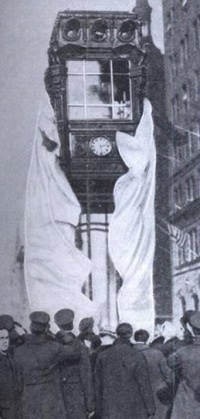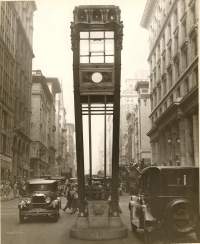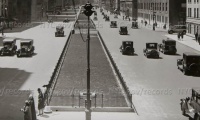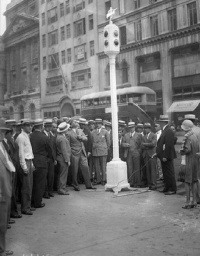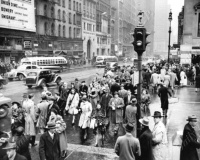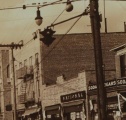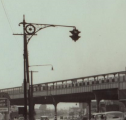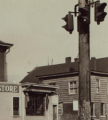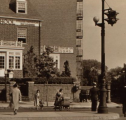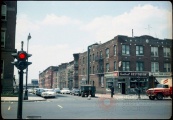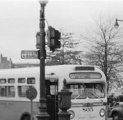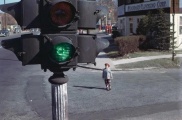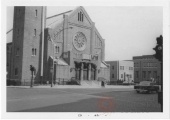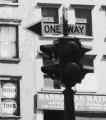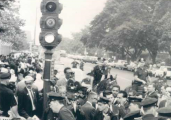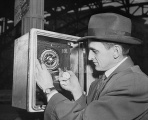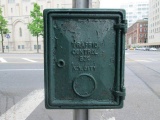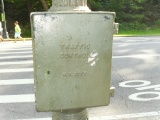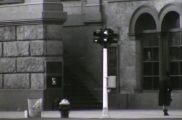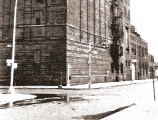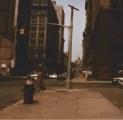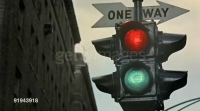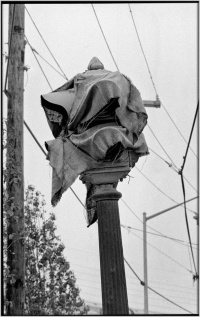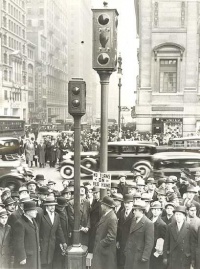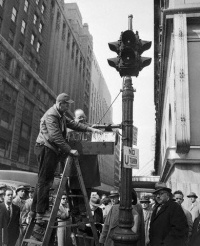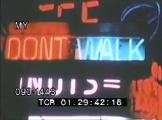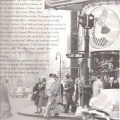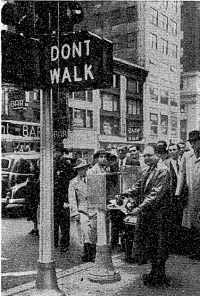Difference between revisions of "New York City Intersections"
(→Bronze signal) |
m |
||
| (230 intermediate revisions by one other user not shown) | |||
| Line 1: | Line 1: | ||
| + | [[File:Work_In_Progress.png]] | ||
| + | <br> | ||
| + | <br> | ||
| + | <br> | ||
| + | <br> | ||
| + | |||
'''This page is under construction.''' | '''This page is under construction.''' | ||
| − | == | + | ==The 1920s== |
| + | ===Traffic control towers=== | ||
Throughout New York City, various intersections (those that were typically major) were controlled mainly by either police officers or traffic control towers. With regards to traffic control towers, these were generally operated by police officers and red and green and red, amber, and green sets were in use. One kind of traffic control tower that is well known to date is the bronze tower, in which was designed by Joseph H. Freedlander and first unveiled by the 5th Av. Association in 1922. Approximately seven were installed on one segment of the major thoroughfare, and these were in use throughout the 1920s. The decorative design of the tower stood out the most, since Freedlander strongly believed in aesthetics. At the top, a police officer was stationed within the inside, and a set of red, amber, and green signal indications were in use. | Throughout New York City, various intersections (those that were typically major) were controlled mainly by either police officers or traffic control towers. With regards to traffic control towers, these were generally operated by police officers and red and green and red, amber, and green sets were in use. One kind of traffic control tower that is well known to date is the bronze tower, in which was designed by Joseph H. Freedlander and first unveiled by the 5th Av. Association in 1922. Approximately seven were installed on one segment of the major thoroughfare, and these were in use throughout the 1920s. The decorative design of the tower stood out the most, since Freedlander strongly believed in aesthetics. At the top, a police officer was stationed within the inside, and a set of red, amber, and green signal indications were in use. | ||
| + | |||
| + | [[File:Bronze tower unveiled.jpg|200px|thumb|right|Joseph H. Freedlander's bronze tower first unveiled in 1922. Courtesy of the New York Times.]] | ||
[[File:62646 253114161496208 2059581299 n zpsf6a62b6c.jpg|200px|thumb|left|One of the seven bronze towers in use on 5th Avenue. This one in particular was located at 5th Av. and W. 42nd St.]] | [[File:62646 253114161496208 2059581299 n zpsf6a62b6c.jpg|200px|thumb|left|One of the seven bronze towers in use on 5th Avenue. This one in particular was located at 5th Av. and W. 42nd St.]] | ||
| Line 9: | Line 18: | ||
While the bronze towers were able to provide adequate traffic control, there were some disadvantages. One to point out is the placement of the tower. The ideal spot at an intersection for this tower was the middle, and this eventually proved to be an obstacle for motorists that wanted to make left and right turns at intersections. Another disadvantage to take into consideration is the use of the amber indication. Though it indicates to motorists to slow down and come to a full stop, many motorists were rather confused by the indication and either tried to speed up to clear the intersection or stopped too early, in which either situation sometimes resulted in a bad accident. A solution to alleviate these common issues was necessary. | While the bronze towers were able to provide adequate traffic control, there were some disadvantages. One to point out is the placement of the tower. The ideal spot at an intersection for this tower was the middle, and this eventually proved to be an obstacle for motorists that wanted to make left and right turns at intersections. Another disadvantage to take into consideration is the use of the amber indication. Though it indicates to motorists to slow down and come to a full stop, many motorists were rather confused by the indication and either tried to speed up to clear the intersection or stopped too early, in which either situation sometimes resulted in a bad accident. A solution to alleviate these common issues was necessary. | ||
| − | == | + | ===First traffic signals=== |
| + | |||
| + | By the mid 1920s, New York City's police department introduced the first automatically-controlled traffic signals. These first appeared in the boroughs of Brooklyn and Manhattan, and they would soon spread to the rest of the other boroughs in the following decade. The new traffic signals, in which were manufactured by the Ruleta company, showed red and green signal indications to motorists, and this became a permanent standard for New York City traffic signals. Ultimately, the amber signal indication was abandoned in 1929. The police department's new system of traffic signals were synchronized, in which were intended for an ideal flow of traffic, and various precincts throughout the city had control centers for police officers to manually adjust signal timing (if necessary). | ||
| − | + | The earliest traffic signals in New York City were commonly attached to unusually tall pedestals, and solely one was in use at a major intersection. In later years, most, if not all, were either modified or removed from service. | |
| − | + | [[File:EarlyNYCTrafficSignal.jpg|200px|thumb|left|One of the earliest traffic signals in use on Park Avenue in Manhattan. Observe the tall pedestal as well. From NYC.gov/records.]] | |
| − | + | ====Original form of caution==== | |
| − | + | Because the traffic signals showed red and green signal indications to motorists, the original form of caution was what is commonly know as a "dark-out period." Both signal indications appeared unlit in between 1 to 3 seconds before the red signal indication then appeared lit. A red clearance then typically followed prior to when the other direction changed from red to green. | |
| + | |||
| + | ===Decline of the traffic control tower=== | ||
As traffic signals began to appear at more locations throughout the city, the ultimate removal of traffic control towers took place at the of end of the 1920s. This includes the seven bronze towers of 5th Avenue in Manhattan. Regarding these in particular, none were saved and preserved when the removal process took place at this time. Even so, an original model of Joseph H. Freedlander's traffic control tower is in the hands of a private collector today, while a replica of this is on display at the Museum of the city of New York. This is true for his original designs of the bronze tower as well. | As traffic signals began to appear at more locations throughout the city, the ultimate removal of traffic control towers took place at the of end of the 1920s. This includes the seven bronze towers of 5th Avenue in Manhattan. Regarding these in particular, none were saved and preserved when the removal process took place at this time. Even so, an original model of Joseph H. Freedlander's traffic control tower is in the hands of a private collector today, while a replica of this is on display at the Museum of the city of New York. This is true for his original designs of the bronze tower as well. | ||
| − | ==Bronze signal== | + | ===Bronze signal=== |
| − | In 1929, the 5th Avenue Association planned to install a new set of traffic signals for one segment of 5th Avenue. As a result, Joseph H. Freedlander was asked to design a traffic signal, and the bronze signal was born. Manufactured by General Electric, the traffic signal was decorative, and a total of four sides were in use for red and green signal indications. Though most signal indications lacked actual cutaway visors, some were attached to these. One noticeable feature of the traffic signal was the statuette of the Roman god Mercury, in which was made of gilded bronze. On July 22nd of 1929, Joseph H. Freedlander's traffic signal was first unveiled and tested at the corner of 5th Avenue and W. 57th Street. In total, 104 would be installed by 1931. From Washington Square Park to W. 59th Street at Central Park. | + | In 1929, the 5th Avenue Association planned to install a new set of traffic signals for one segment of 5th Avenue. As a result, Joseph H. Freedlander was asked to design a traffic signal, and the bronze signal was born. Manufactured by General Electric, the traffic signal was decorative, and a total of four sides were in use for red and green signal indications. Though most signal indications lacked actual cutaway visors, some were attached to these. One noticeable feature of the traffic signal was the statuette of the Roman god Mercury, in which was made of gilded bronze. On July 22nd of 1929, Joseph H. Freedlander's traffic signal was first unveiled and tested at the corner of 5th Avenue and W. 57th Street. In total, 104 would be installed by 1931. From Washington Square Park to W. 59th Street at Central Park. |
| − | [[File:1929 bronze signal debut.jpg|200px|thumb|right| | + | [[File:1929 bronze signal debut.jpg|200px|thumb|right|New York City police department commissioner Grover Whalen tests the first bronze signal at the corner of 5th Avenue and W. 57th Street. July 22nd, 1929.]] |
[[File:Mercury signal with visors.jpg|200px|thumb|left|An example of a bronze signal with visors in use.]] | [[File:Mercury signal with visors.jpg|200px|thumb|left|An example of a bronze signal with visors in use.]] | ||
==Golden age== | ==Golden age== | ||
| + | |||
| + | ===Brief background=== | ||
| + | |||
| + | The 1930s to 1950s is considered as the golden age of two-section traffic signals in New York City, since they first became widespread in the 1930s and eventually the norm by the 1940s. Traffic signals manufactured by the Ruleta company were heavily in use throughout the boroughs; however, at least two other kinds were in existence in this time period. They are traffic signals from General Electric and Horni (presumably). | ||
| + | |||
| + | ===Color=== | ||
| + | |||
| + | In the beginning, with the exception of the G.E. "bronze signals," traffic signals were originally painted black, in which is also true for their pedestals as well. In later years, though, most were repainted dark olive green. | ||
| + | |||
| + | ===Intersection layout=== | ||
| + | |||
| + | A classic set-up at an intersection in New York City had two traffic signals at two corners. It was, by far, the most common set-up throughout the boroughs in this time period. The configuration was rather simple, and one traffic signal was located diagonally across from the other. Each one at a corner. A fixed four-way traffic signal was typically in use, and each head was generally mounted to its own pedestal, in which was manufactured by Union Metal. | ||
| + | |||
| + | Aside from this popular set-up, other arrangements at intersections were in existence as well, due to some factors, such as location and complexity, and, though many traffic signals were attached to pedestals, others were suspended as well. For this set-up in particular, typically only one suspended head controlled an entire intersection. | ||
| + | |||
| + | ====Mounting configurations==== | ||
| + | |||
| + | Below, are a handful of various mounting configurations that were in use in different areas of New York City in the early 20th century. | ||
| + | |||
| + | <gallery mode="nolines" widths=200px> | ||
| + | File:Simple NYC guy wire set-up.jpg|Simple guy wire/utility pole set-up | ||
| + | File:Ruleta guy wire set-up 2.jpg|Second variation with longer arm in use. | ||
| + | File:Wheelie.png|"Wheelie." | ||
| + | File:Ruleta cluster version 3.png|Traffic signal cluster attached to utility pole. | ||
| + | File:Suspended Ruleta version 4.png|Suspended Ruleta. Attached to a street lamp fixture. | ||
| + | File:Brooklyn classic intersection 1962.jpg|The classic signalized intersection of the golden age. | ||
| + | File:Ruleta on island post version 5.png|Ruleta on an island post. From NYC.gov/records | ||
| + | File:Ruleta el suspension Bob Mulero.jpg|El suspension. From Bob Mulero. | ||
| + | </gallery> | ||
| + | |||
| + | ====Traffic signal configurations==== | ||
| + | |||
| + | In the time of the golden age, amongst two-section traffic signals were several different common configurations on the streets, in which each one had its own purpose. Below, are photographs that show these in use in New York City. | ||
| + | |||
| + | |||
| + | '''Louvers''' | ||
| + | |||
| + | This first set shows the use of the square louvers. They were compatible with fixed four-way and individual traffic signals from Ruleta. It was a common practice to use these at signalized intersections that were generally skewed. | ||
| + | |||
| + | <gallery mode="nolines" widths=200px> | ||
| + | File:Ruleta louvers 1.jpg | ||
| + | File:Ruleta louvers 2.jpg | ||
| + | </gallery> | ||
| + | |||
| + | '''Angled Signal Sections''' | ||
| + | |||
| + | These were of another kind, in which were adequate to use at skewed intersections in New York City. Sometimes, at such an intersection, both kinds were used. Either in different heads that were in use or just only one. | ||
| + | |||
| + | <gallery mode="nolines" widths=200px> | ||
| + | File:Angled sections and louvers in one.png|From NYC.gov/records. | ||
| + | File:Angled sections on Ruleta.jpg | ||
| + | </gallery> | ||
| + | |||
| + | |||
| + | '''Protected Turn Signal Attachments''' | ||
| + | |||
| + | In the days of red and green signal indications, certain signalized intersections that required additional phases for turns were taken into consideration. As a result, 8" green arrow signal indications were in use, in which they represented either protected left or right turn movements for vehicular traffic. An individual signal section was attached to an existing two-section vehicular head, and there was a typical separation between both. Other times, a separation was between the red and green signal indications. What should be noted as well is that traffic signal clusters were solely used for arrow signal indications. | ||
| + | |||
| + | <gallery mode="nolines" widths=200px> | ||
| + | File:Protected left turn attachment nyc.jpg|Example of a set-up that has the separation between the red and green signal indications. Courtesy of the Brooklyn Historical Society. | ||
| + | File:Protected turn signal attachments staten island nyc.png|This set-up shows the individual signal sections (bottom) attached to the two-section vehicular heads. Courtesy of NYC.gov/records. | ||
| + | </gallery> | ||
| + | |||
| + | '''Long Tunnel Visors''' | ||
| + | |||
| + | Though this was uncommon, long tunnel visors were used in later years on two-section traffic signals. This was typically a result of a modification at an intersection. | ||
| + | |||
| + | <gallery mode="nolines" widths=200px>File:Ruleta with long tunnel visors.jpg | ||
| + | </gallery> | ||
| + | |||
| + | '''Short visors''' | ||
| + | |||
| + | Often times, a traffic signal that was extremely close to a curb at an intersection typically had one pair of short visors attached to it. With the case of a fixed four-way traffic signal, the side that faced the curb of a corner had the set installed. This is true for individual heads as well. Overall, the simple purpose behind these short visors was to prevent damage by a large vehicle making a turn at the corner. | ||
| + | |||
| + | <gallery mode="nolines" widths=200px> | ||
| + | File:Short visors 2.png | ||
| + | File:Short visors 3.jpg | ||
| + | </gallery> | ||
| + | |||
| + | '''Blank doors''' | ||
| + | |||
| + | These were common amongst fixed four-way Ruleta traffic signals, and they typically covered one side (sometimes more than one side as well) of signal indications that were not intended to face either that of a one-way street or curb. | ||
| + | |||
| + | <gallery mode="nolines" widths=200px> | ||
| + | File:Blank doors.png | ||
| + | File:Blank doors 2.jpg | ||
| + | </gallery> | ||
| + | |||
| + | '''Three signal indications''' | ||
| + | |||
| + | Though red and green signal indications were the norm throughout New York City in the early 20th century, there were also three-section vehicular signals in service, in which were presumably manufactured by either the Ruleta or Horni company. These were scattered at various locations in some of the boroughs, such as Brooklyn and Queens, and the traffic signals were commonly in use in the general areas of schools. These operated somewhat differently than ordinary red and green traffic signals. When school was in session, a traffic signal in the general area operated normally; however, the red and green signal indications were solely used. The set-up was put into flash mode when children were not in school, so one direction had a flashing amber indication, while the other direction had a flashing red indication. | ||
| + | |||
| + | <gallery mode="nolines" widths=200px> | ||
| + | File:NYC three section traffic signal Bob Mulero.jpg | ||
| + | File:NYC three section traffic signal.png | ||
| + | </gallery> | ||
| + | |||
| + | ===Signal controllers=== | ||
| + | Most two-section traffic signals throughout New York City were controlled by electro-mechanical signal controllers manufactured by General Electric. At least two kinds from the company were in use on the streets of New York City, and they are the type F and D. | ||
| + | |||
| + | <gallery mode="nolines" widths=200px> | ||
| + | File:Nyc ge type d.jpg|An example of a type D from G.E. in service. Manhattan. Early 1950s. | ||
| + | File:Nyc ge type F malcom macpherson.jpg|Type F from G.E. located at Central Park in Manhattan. Taken by Malcolm MacPherson. | ||
| + | </gallery> | ||
| + | |||
| + | In the beginning, the label stamped on cabinets that housed the actual signal controllers was ''"TRAFFIC CONTROL BOX N.Y. CITY;"'' however, in later years, this was changed to ''"TRAFFIC CONTROL N.Y. CITY."'' Below, are two pictures that show these two labels. | ||
| + | |||
| + | |||
| + | <gallery mode="nolines" widths=200px> | ||
| + | File:First label.jpg|Taken by Joseph DeMarco. | ||
| + | File:Label 2.JPG|Taken by Steven Gembara. | ||
| + | </gallery> | ||
| + | |||
| + | Another kind of an electro-mechanical signal controller was used for two-section traffic signals in the 1950s, and it was the model M-30 from Marbelite. A modern (then) head manufactured by Marbelite that generally replaced an older one in service was controlled by it. Many bronze signals by the late 1950s on 5th Avenue in Manhattan were controlled by them as well. | ||
| + | |||
| + | At this time, the new label stamped on the cabinet was ''"TRAFFIC CONTROL NEW YORK CITY,''" in which is still the label in use today on all cabinets throughout the boroughs. | ||
| + | |||
| + | ===Later years=== | ||
| + | |||
| + | ====Upgrades==== | ||
| + | In the 1950s, two-section traffic signals and their hardware already in service were aging, and many intersections throughout various locations of New York City were upgraded. Some common practices that were done regarding this are listed below. | ||
| + | |||
| + | '''Method 1''' | ||
| + | |||
| + | Removal of the entire original set-up, in which was replaced by a new set-up that consisted of a cluster of heads manufactured by Marbelite, clarinet-shaped pedestal, and new signal controller. | ||
| + | |||
| + | <gallery mode="nolines" widths=200px> | ||
| + | File:1146745 292003187607305 1814578510 n.jpg | ||
| + | File:Nyc 50s set-up new.png | ||
| + | </gallery> | ||
| + | |||
| + | '''Method 2''' | ||
| + | |||
| + | Replacement of original traffic signal with new head. Attached to existing Union Metal pedestal, and the set-up is either still operated by original G.E. signal controller or a brand new one. | ||
| + | |||
| + | <gallery mode="nolines" widths=200px> | ||
| + | File:Method 2.jpg | ||
| + | File:1185819 301496166658007 2139333666 n.jpg | ||
| + | </gallery> | ||
| + | |||
| + | '''Method 3''' | ||
| + | |||
| + | Union Metal pedestal is replaced with a brand new clarinet-shaped pedestal, and the original traffic signal is attached to it. Either still controlled by original G.E. signal controller or a brand new one. | ||
| + | |||
| + | <gallery mode="nolines" widths=200px> | ||
| + | File:Method 3.jpg | ||
| + | File:Method 3 1.jpg | ||
| + | </gallery> | ||
| + | |||
| + | '''Method 4''' | ||
| + | |||
| + | Regarding the "wheelie" set-up in particular, some in various locations of New York City were replaced with modern mast-arm/guy wire poles, and newly installed Marbelite clusters were in use. In general, only one, like its predecessor, controlled an entire intersection. A rather odd, yet uncommon set-up. | ||
| + | |||
| + | <gallery mode="nolines" widths=200px> | ||
| + | File:Method 4.jpg | ||
| + | File:Method 4 1.jpg | ||
| + | </gallery> | ||
| + | |||
| + | ====New form of caution introduced==== | ||
| + | In 1952, New York City's department of traffic first experimented with a new form of caution amongst various two-section traffic signals in the five boroughs. It is referred to as an overlap, in which both the red and green signal indications are lit momentarily prior to when the green signal indication terminates. Its main benefit was that it improved a motorist's initial reaction, and, in turn, significantly decreased sudden stops and accidents. As a result, this eventually became the standard for most two-section traffic signals in New York City in the 1950s. | ||
| + | |||
| + | [[File:1621760 361078474033109 341548989 n.png|200px|thumb|right|A Ruleta from the 1950s showing the overlap. Courtesy of GettyImages.]] | ||
| + | |||
| + | [[File:Last days 1989 Matt Weber.jpg|200px|thumb|left|In 1989, photographer Matt Weber snapped this picture of a Ruleta in its final days in Brooklyn. It was covered, and it awaited its removal. By this time, Ruleta traffic signals were few and far between in New York City.]] | ||
| + | |||
| + | ===Beginning of the end=== | ||
| + | The 1950s in New York City saw the revitalization of the amber signal indication, which ultimately marked the beginning of the transition from two-section to three-section traffic signals. In following years, countless signalized intersections throughout the boroughs would be upgraded, and the process took slightly over 50 years to fully complete. Though a large percentage of New York City's signalized intersections were successfully modernized by the year 1970, a smaller percentage of signalized intersections that were scattered in some areas of New York City were untouched; however, these would be altered in later years. By the 1990s, survivors were solely located in certain areas of the borough Queens in New York City, such as Ozone Park, the Rockaways, and Richmond Hill. These at intersections would remain in existence in the 2000s, but the decade would mark the final stage of the removal process, in which began years earlier. Alas, in 2006 or so, the last survivors from the Rockaways and Richmond Hill in Queens were finally removed from useful service, and, since then, two-section vehicular heads in New York City have been extinct. | ||
| + | |||
| + | ===Other notable occurrences=== | ||
| + | |||
| + | Throughout the golden age of New York City's traffic control history, other events that are significant have been mentioned in published literature. | ||
| + | |||
| + | ====Earliest pedestrian signals in use==== | ||
| + | |||
| + | =====The Dr. John Harriss Signal===== | ||
| + | |||
| + | In 1934, New York City's police department first experimented with a pedestrian signal, in which is, at this time, the earliest of its kind known to have been in use on the streets of the city. Designed by New York City deputy chief Dr. John Harriss, the signal was also dedicated to motorists, since red and green signal indications were in use. It was timed for approximately 120 seconds, and one direction of vehicular traffic had the right-of-way. Once the phase terminated, then the red signal indication appeared illuminated along with the hand. It was then that pedestrians were able to cross, while motorists waited. The red signal indication appeared unlit, while the red hand was still illuminated, in which meant pedestrians had to clear the intersection before the next phase of vehicular traffic began. Before the entire cycle was completed, a two second interval was observed, and all motorists and pedestrian signals waited. | ||
| + | |||
| + | From what is known, two intersections on 5th Av. in Manhattan had these signals in use, and it is unclear if they were actually successful. It is unlikely that they remained in service for a long period of time. | ||
| + | |||
| + | [[File:Earliest pedestrian signal vehicular signal nyc dr harriss light.jpg|200px|thumb|right|Dr. John Harriss' signal in use on 5th Avenue in Manhattan.]] | ||
| + | |||
| + | =====A second kind of pedestrian signal===== | ||
| + | |||
| + | Beginning in the 1940s, a second kind of pedestrian signal was introduced by New York City's police department and experimented with in certain locations near Times Square in Manhattan. Though no actual photographs show this second kind in service, a New York Times article briefly discusses it. It was mechanical and rather boxy in appearance, in which parts changed signal indications dedicated to pedestrians. Not much is known about the signal at this time, due to little or no information elsewhere. | ||
| + | |||
| + | [[File:First worded pedestrian signal nyc 1952.jpg|200px|thumb|left|T.T. Wiley and a worker install one of the first worded pedestrian signals in Manhattan in 1952, while a crowd below the two gentlemen watch.]] | ||
| + | |||
| + | =====Debut of the first worded pedestrian signals===== | ||
| + | |||
| + | February of 1952 marked an important event in New York City's traffic control history, since the first worded pedestrian signals were installed and placed into useful service there. At the time, the city's traffic commissioner T.T. Wiley installed seven neon pedestrian signals near and at Times Square in Manhattan. Each one was horizontal in appearance, and red "DONT WALK" and green "WALK" signal indications were in use. Manufactured by the Crouse-Hinds company, the pedestrian signals operated along with two-section vehicular signals at the time of their debut. The sequence of one is not different at all when compared to the earlier pedestrian signals that were in use in Manhattan. Vehicular traffic had the right-of-way, while pedestrians waited. Once both phases of vehicular traffic terminated, pedestrians were indicated to cross by a steady "WALK" signal, in which appeared illuminated for approximately 11 seconds. Once this terminated, a flashing "DONT WALK" clearance followed, so that pedestrians already on the crosswalk had ample time to finish to cross. When the "DONT WALK" signal indication appeared steady, one direction of vehicular traffic signal had the right-of-way, and the entire sequence repeated itself. Concerning the "DONT WALK" signal indication, because of the design of the pedestrian signal, the words "DONT" and "WALK" were in use, so a steady and flashing "DONT WALK" signal indication contained a red "DONT" and green "WALK." Observed by T.T. Wiley as a disadvantage, in which confused numerous pedestrians, T.T. Wiley's decision, nearly two years after he first installed them, was to remove the existing ones from useful service and discontinue the traffic department's installment of others for the future. The Crouse-Hinds pedestrian signals have been extinct from Manhattan streets since around 1955. | ||
| + | |||
| + | |||
| + | Below, are two photographs that shows this kind of worded pedestrian signal in service in Manhattan. | ||
| + | |||
| + | <gallery mode="nolines" widths=200px> | ||
| + | File:Nyc crouse hinds neon pedestrian signal.jpg | ||
| + | File:First worded pedestrian signal nyc 1950s.jpg | ||
| + | </gallery> | ||
| + | |||
| + | ==The 1950s to 1960s== | ||
| + | |||
| + | ===A new beginning=== | ||
| + | |||
| + | In 1950, New York City's police department officially left the supervision of the traffic control system. Thus, the establishment of the Department of Traffic. | ||
| + | |||
| + | ===Changes in the traffic control system=== | ||
| + | |||
| + | Shortly after the establishment of the Department of Traffic in 1950, significant changes in New York City's traffic control system would occur in this time period. Modernization would play a big role, and, as a result, old standards would be eliminated to alleviate issues both big and small, not to mention improve the safety for all motorists. New ones would take their place and change New York City intersections entirely. | ||
| + | |||
| + | |||
| + | ====Amber revival==== | ||
| + | |||
| + | After the amber signal indication was abandoned 23 years earlier, the revival of this signal indication occurred in 1952. Based on New York City's then Department of Traffic, future installations of signalized intersections would use three-section (red, amber and, green) traffic signals. This action was to benefit the safety of motorists that encounter the critical moment when the signal indications change. Signalized intersections already in existence were eventually modernized, and the conversion from two-section to three-section traffic signals was greatly evident from this decade until the 1970s decade. | ||
| + | |||
| + | =====Manufacturer===== | ||
| + | |||
| + | The original manufacturer of the first three-section traffic signals in New York City was Marbelite, and, based in the borough Brooklyn, the company was responsible of the production of the city's signal equipment until the end of the 1970s. | ||
| + | |||
| + | ====Color==== | ||
| + | |||
| + | =====Three-section traffic signals===== | ||
| + | |||
| + | The Department of Traffic originally decided to paint all three-section traffic signals installed in the 1950s dark olive green, which was a continued practice, because two-section traffic signals of the time were also painted this color. In addition to this, it was believed that dark olive green was an ideal color that was visible to motorists on New York City streets. | ||
| + | |||
| + | =====Hardware===== | ||
| + | |||
| + | Aside from the traffic signals, the actual hardware for the heads were to match the then standard color. | ||
| + | |||
| + | ====T.T. Wiley introduces the Winko-Matic pedestrian signal==== | ||
| + | |||
| + | In 1955, in the borough Manhattan in New York City, the first eight neon pedestrian signals from the Winko-Matic company made their debut. Installed by the Department of Traffic, these heads (including new three-section traffic signals) were originally located at W. 34th St. and 7th Av. | ||
| + | |||
| + | These were the second of their kind to be used on New York City streets, since, two years earlier, a handful of previous pedestrian signals (manufactured by the Crouse-Hinds company), which were actually the first "DONT WALK" and "WALK" heads installed in New York City, were unsuccessful while in service, due to a design flaw. | ||
| + | |||
| + | Eventually, 300 other pedestrian signals from the Winko-Matic company would be ordered, and they would be installed at other signalized intersections in Manhattan. Additionally, others would be put into service at certain locations in most of the other boroughs. | ||
| + | |||
| + | [[File:ARTICLE1 zpsa36892ae.png|200px|thumb|right|Then traffic commissioner T.T. Wiley turns on the first eight pedestrian signals at W. 34th St. and 7th Av. A group of people behind him watch. 1955. Courtesy of the New York Times.]] | ||
| + | |||
| + | [[File:1.png|200px|thumb|left|The colors of the signal indications of a Winko-Matic unit. Courtesy of GettyImages.]] | ||
| + | =====Description===== | ||
| + | |||
| + | The neon pedestrian signals from Winko-Matic were bulky in appearance, not to mention heavy. Like traffic signals of the time, these units were painted dark olive green. The signal indications of "DONT WALK" and "WALK" were red and green (respectively), and the configuration was bi-modal (the first of its kind to be used on New York City streets at the time of its debut). Four ventilation strips were located behind each housing, which provided an escape of unwanted heat inside. At least three variations of this pedestrian signal from Winko-Matic were installed throughout New York City in the 1950s (and possibly 1960s) decade. | ||
| + | |||
| + | |||
| + | ====New way to suspend traffic signals==== | ||
| + | |||
| + | Pole mounted traffic signals in the 1950s in New York City were widely abundant; however, the Department of Traffic was faced with a rather common issue regarding visibility. Many that were located in different areas were sometimes hard to see from a motorist's point of view, merely due to obstructions, such as trees, signs, building lighting, etc. To alleviate this problem, the Department of Traffic first introduced the mast-arm/guy wire set-up as early as 1954. In future years, this would have a significant impact on how traffic signals throughout New York City are mounted. | ||
| + | |||
| + | |||
| + | According to an article [[Media:File:1010444 685887144775429 2001797484 n.ogg]] published by the ''"American City"'' in November of 1955, the set-up is 20 ft. high and provides an adequate clearance level for vehicular traffic. The mast-arm/guy wire set-up consists of a copper/nickel/steel alloy, which provides a long lifespan with little maintenance required. Overall, the mast-arm/guy wire set-up of the New York City has not changed in any way, and it is still the preferred way to suspend traffic signals there. | ||
| + | |||
| + | |||
| + | Countless intersections would be modernized throughout New York City in the following years, and, by 1970, a large percentage of the city's traffic signals would be successfully suspended. | ||
Latest revision as of 00:29, 13 July 2016
This page is under construction.
Contents
The 1920s
Traffic control towers
Throughout New York City, various intersections (those that were typically major) were controlled mainly by either police officers or traffic control towers. With regards to traffic control towers, these were generally operated by police officers and red and green and red, amber, and green sets were in use. One kind of traffic control tower that is well known to date is the bronze tower, in which was designed by Joseph H. Freedlander and first unveiled by the 5th Av. Association in 1922. Approximately seven were installed on one segment of the major thoroughfare, and these were in use throughout the 1920s. The decorative design of the tower stood out the most, since Freedlander strongly believed in aesthetics. At the top, a police officer was stationed within the inside, and a set of red, amber, and green signal indications were in use.
While the bronze towers were able to provide adequate traffic control, there were some disadvantages. One to point out is the placement of the tower. The ideal spot at an intersection for this tower was the middle, and this eventually proved to be an obstacle for motorists that wanted to make left and right turns at intersections. Another disadvantage to take into consideration is the use of the amber indication. Though it indicates to motorists to slow down and come to a full stop, many motorists were rather confused by the indication and either tried to speed up to clear the intersection or stopped too early, in which either situation sometimes resulted in a bad accident. A solution to alleviate these common issues was necessary.
First traffic signals
By the mid 1920s, New York City's police department introduced the first automatically-controlled traffic signals. These first appeared in the boroughs of Brooklyn and Manhattan, and they would soon spread to the rest of the other boroughs in the following decade. The new traffic signals, in which were manufactured by the Ruleta company, showed red and green signal indications to motorists, and this became a permanent standard for New York City traffic signals. Ultimately, the amber signal indication was abandoned in 1929. The police department's new system of traffic signals were synchronized, in which were intended for an ideal flow of traffic, and various precincts throughout the city had control centers for police officers to manually adjust signal timing (if necessary).
The earliest traffic signals in New York City were commonly attached to unusually tall pedestals, and solely one was in use at a major intersection. In later years, most, if not all, were either modified or removed from service.
Original form of caution
Because the traffic signals showed red and green signal indications to motorists, the original form of caution was what is commonly know as a "dark-out period." Both signal indications appeared unlit in between 1 to 3 seconds before the red signal indication then appeared lit. A red clearance then typically followed prior to when the other direction changed from red to green.
Decline of the traffic control tower
As traffic signals began to appear at more locations throughout the city, the ultimate removal of traffic control towers took place at the of end of the 1920s. This includes the seven bronze towers of 5th Avenue in Manhattan. Regarding these in particular, none were saved and preserved when the removal process took place at this time. Even so, an original model of Joseph H. Freedlander's traffic control tower is in the hands of a private collector today, while a replica of this is on display at the Museum of the city of New York. This is true for his original designs of the bronze tower as well.
Bronze signal
In 1929, the 5th Avenue Association planned to install a new set of traffic signals for one segment of 5th Avenue. As a result, Joseph H. Freedlander was asked to design a traffic signal, and the bronze signal was born. Manufactured by General Electric, the traffic signal was decorative, and a total of four sides were in use for red and green signal indications. Though most signal indications lacked actual cutaway visors, some were attached to these. One noticeable feature of the traffic signal was the statuette of the Roman god Mercury, in which was made of gilded bronze. On July 22nd of 1929, Joseph H. Freedlander's traffic signal was first unveiled and tested at the corner of 5th Avenue and W. 57th Street. In total, 104 would be installed by 1931. From Washington Square Park to W. 59th Street at Central Park.
Golden age
Brief background
The 1930s to 1950s is considered as the golden age of two-section traffic signals in New York City, since they first became widespread in the 1930s and eventually the norm by the 1940s. Traffic signals manufactured by the Ruleta company were heavily in use throughout the boroughs; however, at least two other kinds were in existence in this time period. They are traffic signals from General Electric and Horni (presumably).
Color
In the beginning, with the exception of the G.E. "bronze signals," traffic signals were originally painted black, in which is also true for their pedestals as well. In later years, though, most were repainted dark olive green.
Intersection layout
A classic set-up at an intersection in New York City had two traffic signals at two corners. It was, by far, the most common set-up throughout the boroughs in this time period. The configuration was rather simple, and one traffic signal was located diagonally across from the other. Each one at a corner. A fixed four-way traffic signal was typically in use, and each head was generally mounted to its own pedestal, in which was manufactured by Union Metal.
Aside from this popular set-up, other arrangements at intersections were in existence as well, due to some factors, such as location and complexity, and, though many traffic signals were attached to pedestals, others were suspended as well. For this set-up in particular, typically only one suspended head controlled an entire intersection.
Mounting configurations
Below, are a handful of various mounting configurations that were in use in different areas of New York City in the early 20th century.
Traffic signal configurations
In the time of the golden age, amongst two-section traffic signals were several different common configurations on the streets, in which each one had its own purpose. Below, are photographs that show these in use in New York City.
Louvers
This first set shows the use of the square louvers. They were compatible with fixed four-way and individual traffic signals from Ruleta. It was a common practice to use these at signalized intersections that were generally skewed.
Angled Signal Sections
These were of another kind, in which were adequate to use at skewed intersections in New York City. Sometimes, at such an intersection, both kinds were used. Either in different heads that were in use or just only one.
Protected Turn Signal Attachments
In the days of red and green signal indications, certain signalized intersections that required additional phases for turns were taken into consideration. As a result, 8" green arrow signal indications were in use, in which they represented either protected left or right turn movements for vehicular traffic. An individual signal section was attached to an existing two-section vehicular head, and there was a typical separation between both. Other times, a separation was between the red and green signal indications. What should be noted as well is that traffic signal clusters were solely used for arrow signal indications.
Long Tunnel Visors
Though this was uncommon, long tunnel visors were used in later years on two-section traffic signals. This was typically a result of a modification at an intersection.
Short visors
Often times, a traffic signal that was extremely close to a curb at an intersection typically had one pair of short visors attached to it. With the case of a fixed four-way traffic signal, the side that faced the curb of a corner had the set installed. This is true for individual heads as well. Overall, the simple purpose behind these short visors was to prevent damage by a large vehicle making a turn at the corner.
Blank doors
These were common amongst fixed four-way Ruleta traffic signals, and they typically covered one side (sometimes more than one side as well) of signal indications that were not intended to face either that of a one-way street or curb.
Three signal indications
Though red and green signal indications were the norm throughout New York City in the early 20th century, there were also three-section vehicular signals in service, in which were presumably manufactured by either the Ruleta or Horni company. These were scattered at various locations in some of the boroughs, such as Brooklyn and Queens, and the traffic signals were commonly in use in the general areas of schools. These operated somewhat differently than ordinary red and green traffic signals. When school was in session, a traffic signal in the general area operated normally; however, the red and green signal indications were solely used. The set-up was put into flash mode when children were not in school, so one direction had a flashing amber indication, while the other direction had a flashing red indication.
Signal controllers
Most two-section traffic signals throughout New York City were controlled by electro-mechanical signal controllers manufactured by General Electric. At least two kinds from the company were in use on the streets of New York City, and they are the type F and D.
In the beginning, the label stamped on cabinets that housed the actual signal controllers was "TRAFFIC CONTROL BOX N.Y. CITY;" however, in later years, this was changed to "TRAFFIC CONTROL N.Y. CITY." Below, are two pictures that show these two labels.
Another kind of an electro-mechanical signal controller was used for two-section traffic signals in the 1950s, and it was the model M-30 from Marbelite. A modern (then) head manufactured by Marbelite that generally replaced an older one in service was controlled by it. Many bronze signals by the late 1950s on 5th Avenue in Manhattan were controlled by them as well.
At this time, the new label stamped on the cabinet was "TRAFFIC CONTROL NEW YORK CITY," in which is still the label in use today on all cabinets throughout the boroughs.
Later years
Upgrades
In the 1950s, two-section traffic signals and their hardware already in service were aging, and many intersections throughout various locations of New York City were upgraded. Some common practices that were done regarding this are listed below.
Method 1
Removal of the entire original set-up, in which was replaced by a new set-up that consisted of a cluster of heads manufactured by Marbelite, clarinet-shaped pedestal, and new signal controller.
Method 2
Replacement of original traffic signal with new head. Attached to existing Union Metal pedestal, and the set-up is either still operated by original G.E. signal controller or a brand new one.
Method 3
Union Metal pedestal is replaced with a brand new clarinet-shaped pedestal, and the original traffic signal is attached to it. Either still controlled by original G.E. signal controller or a brand new one.
Method 4
Regarding the "wheelie" set-up in particular, some in various locations of New York City were replaced with modern mast-arm/guy wire poles, and newly installed Marbelite clusters were in use. In general, only one, like its predecessor, controlled an entire intersection. A rather odd, yet uncommon set-up.
New form of caution introduced
In 1952, New York City's department of traffic first experimented with a new form of caution amongst various two-section traffic signals in the five boroughs. It is referred to as an overlap, in which both the red and green signal indications are lit momentarily prior to when the green signal indication terminates. Its main benefit was that it improved a motorist's initial reaction, and, in turn, significantly decreased sudden stops and accidents. As a result, this eventually became the standard for most two-section traffic signals in New York City in the 1950s.
Beginning of the end
The 1950s in New York City saw the revitalization of the amber signal indication, which ultimately marked the beginning of the transition from two-section to three-section traffic signals. In following years, countless signalized intersections throughout the boroughs would be upgraded, and the process took slightly over 50 years to fully complete. Though a large percentage of New York City's signalized intersections were successfully modernized by the year 1970, a smaller percentage of signalized intersections that were scattered in some areas of New York City were untouched; however, these would be altered in later years. By the 1990s, survivors were solely located in certain areas of the borough Queens in New York City, such as Ozone Park, the Rockaways, and Richmond Hill. These at intersections would remain in existence in the 2000s, but the decade would mark the final stage of the removal process, in which began years earlier. Alas, in 2006 or so, the last survivors from the Rockaways and Richmond Hill in Queens were finally removed from useful service, and, since then, two-section vehicular heads in New York City have been extinct.
Other notable occurrences
Throughout the golden age of New York City's traffic control history, other events that are significant have been mentioned in published literature.
Earliest pedestrian signals in use
The Dr. John Harriss Signal
In 1934, New York City's police department first experimented with a pedestrian signal, in which is, at this time, the earliest of its kind known to have been in use on the streets of the city. Designed by New York City deputy chief Dr. John Harriss, the signal was also dedicated to motorists, since red and green signal indications were in use. It was timed for approximately 120 seconds, and one direction of vehicular traffic had the right-of-way. Once the phase terminated, then the red signal indication appeared illuminated along with the hand. It was then that pedestrians were able to cross, while motorists waited. The red signal indication appeared unlit, while the red hand was still illuminated, in which meant pedestrians had to clear the intersection before the next phase of vehicular traffic began. Before the entire cycle was completed, a two second interval was observed, and all motorists and pedestrian signals waited.
From what is known, two intersections on 5th Av. in Manhattan had these signals in use, and it is unclear if they were actually successful. It is unlikely that they remained in service for a long period of time.
A second kind of pedestrian signal
Beginning in the 1940s, a second kind of pedestrian signal was introduced by New York City's police department and experimented with in certain locations near Times Square in Manhattan. Though no actual photographs show this second kind in service, a New York Times article briefly discusses it. It was mechanical and rather boxy in appearance, in which parts changed signal indications dedicated to pedestrians. Not much is known about the signal at this time, due to little or no information elsewhere.
Debut of the first worded pedestrian signals
February of 1952 marked an important event in New York City's traffic control history, since the first worded pedestrian signals were installed and placed into useful service there. At the time, the city's traffic commissioner T.T. Wiley installed seven neon pedestrian signals near and at Times Square in Manhattan. Each one was horizontal in appearance, and red "DONT WALK" and green "WALK" signal indications were in use. Manufactured by the Crouse-Hinds company, the pedestrian signals operated along with two-section vehicular signals at the time of their debut. The sequence of one is not different at all when compared to the earlier pedestrian signals that were in use in Manhattan. Vehicular traffic had the right-of-way, while pedestrians waited. Once both phases of vehicular traffic terminated, pedestrians were indicated to cross by a steady "WALK" signal, in which appeared illuminated for approximately 11 seconds. Once this terminated, a flashing "DONT WALK" clearance followed, so that pedestrians already on the crosswalk had ample time to finish to cross. When the "DONT WALK" signal indication appeared steady, one direction of vehicular traffic signal had the right-of-way, and the entire sequence repeated itself. Concerning the "DONT WALK" signal indication, because of the design of the pedestrian signal, the words "DONT" and "WALK" were in use, so a steady and flashing "DONT WALK" signal indication contained a red "DONT" and green "WALK." Observed by T.T. Wiley as a disadvantage, in which confused numerous pedestrians, T.T. Wiley's decision, nearly two years after he first installed them, was to remove the existing ones from useful service and discontinue the traffic department's installment of others for the future. The Crouse-Hinds pedestrian signals have been extinct from Manhattan streets since around 1955.
Below, are two photographs that shows this kind of worded pedestrian signal in service in Manhattan.
The 1950s to 1960s
A new beginning
In 1950, New York City's police department officially left the supervision of the traffic control system. Thus, the establishment of the Department of Traffic.
Changes in the traffic control system
Shortly after the establishment of the Department of Traffic in 1950, significant changes in New York City's traffic control system would occur in this time period. Modernization would play a big role, and, as a result, old standards would be eliminated to alleviate issues both big and small, not to mention improve the safety for all motorists. New ones would take their place and change New York City intersections entirely.
Amber revival
After the amber signal indication was abandoned 23 years earlier, the revival of this signal indication occurred in 1952. Based on New York City's then Department of Traffic, future installations of signalized intersections would use three-section (red, amber and, green) traffic signals. This action was to benefit the safety of motorists that encounter the critical moment when the signal indications change. Signalized intersections already in existence were eventually modernized, and the conversion from two-section to three-section traffic signals was greatly evident from this decade until the 1970s decade.
Manufacturer
The original manufacturer of the first three-section traffic signals in New York City was Marbelite, and, based in the borough Brooklyn, the company was responsible of the production of the city's signal equipment until the end of the 1970s.
Color
Three-section traffic signals
The Department of Traffic originally decided to paint all three-section traffic signals installed in the 1950s dark olive green, which was a continued practice, because two-section traffic signals of the time were also painted this color. In addition to this, it was believed that dark olive green was an ideal color that was visible to motorists on New York City streets.
Hardware
Aside from the traffic signals, the actual hardware for the heads were to match the then standard color.
T.T. Wiley introduces the Winko-Matic pedestrian signal
In 1955, in the borough Manhattan in New York City, the first eight neon pedestrian signals from the Winko-Matic company made their debut. Installed by the Department of Traffic, these heads (including new three-section traffic signals) were originally located at W. 34th St. and 7th Av.
These were the second of their kind to be used on New York City streets, since, two years earlier, a handful of previous pedestrian signals (manufactured by the Crouse-Hinds company), which were actually the first "DONT WALK" and "WALK" heads installed in New York City, were unsuccessful while in service, due to a design flaw.
Eventually, 300 other pedestrian signals from the Winko-Matic company would be ordered, and they would be installed at other signalized intersections in Manhattan. Additionally, others would be put into service at certain locations in most of the other boroughs.
Description
The neon pedestrian signals from Winko-Matic were bulky in appearance, not to mention heavy. Like traffic signals of the time, these units were painted dark olive green. The signal indications of "DONT WALK" and "WALK" were red and green (respectively), and the configuration was bi-modal (the first of its kind to be used on New York City streets at the time of its debut). Four ventilation strips were located behind each housing, which provided an escape of unwanted heat inside. At least three variations of this pedestrian signal from Winko-Matic were installed throughout New York City in the 1950s (and possibly 1960s) decade.
New way to suspend traffic signals
Pole mounted traffic signals in the 1950s in New York City were widely abundant; however, the Department of Traffic was faced with a rather common issue regarding visibility. Many that were located in different areas were sometimes hard to see from a motorist's point of view, merely due to obstructions, such as trees, signs, building lighting, etc. To alleviate this problem, the Department of Traffic first introduced the mast-arm/guy wire set-up as early as 1954. In future years, this would have a significant impact on how traffic signals throughout New York City are mounted.
According to an article Media:File:1010444 685887144775429 2001797484 n.ogg published by the "American City" in November of 1955, the set-up is 20 ft. high and provides an adequate clearance level for vehicular traffic. The mast-arm/guy wire set-up consists of a copper/nickel/steel alloy, which provides a long lifespan with little maintenance required. Overall, the mast-arm/guy wire set-up of the New York City has not changed in any way, and it is still the preferred way to suspend traffic signals there.
Countless intersections would be modernized throughout New York City in the following years, and, by 1970, a large percentage of the city's traffic signals would be successfully suspended.

